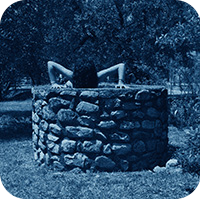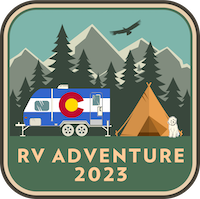America -> Italy
And so it begins. Let me put this succinctly.
I am on my way to Italy.
I have been invited to receive an award/recognition from my great-grandparents’ hometown.
I have had almost no contact with or details from this town.
I am taking my not-so-worldly parents.
I am also visiting Matera, where I have been invited to give a presentation.
I am not sure what the hell is going to happen.
Follow the travails here.
“Sometimes the spaghetti likes to be alone.”
If you’ve seen the movie Big Night you’ll recognize that quote from the irascible chef Primo as he deals with 1950’s American restaurant-goers who think Italian food is spaghetti with red sauce and meatballs and nothing more.
Today of course Italian eateries are big business — from gourmet to fast food to just sucky (I worked there in college, trust me). In such a crowded space often the simplicity of homemade Italian food can be hard to find.
Anna Maria Pasteria, a small trattoria in Wrigleyville, serves uncomplicated, traditional Italian dishes. No fusion, nothing exotic. Just amazing homemade pasta, veggies, and meats. Two sisters, Maria Spinelli and Anna Picciolini, run the place and pervade it with a warmth that really is the closest thing I’ve found to the way restaurants feel in Italy. Close, comfortable, happy. And the service matches the food. Not showy, but ample.
Anna and Maria are originally from Ripacandida, Italy a small, hill-topping down about 15 minutes from Barile, my destination on Friday. Though the menu runs the gamut of Italian dishes that just about anyone would recognize, the sisters do make southern fare. These plates are invariably simple: pasta, a light sauce with herbs, and a meat. (Try the Pollo ai pignoli or the Capellini carrettiera.) Anna Maria Pasteria also serves a heavenly Tiramisu. Lighter than air.
A great send-off dinner before we embark for Italy. Highly recommended.
Going to be in Matera, Italy on July 12 perchance?
If so, swing on by for my talk.
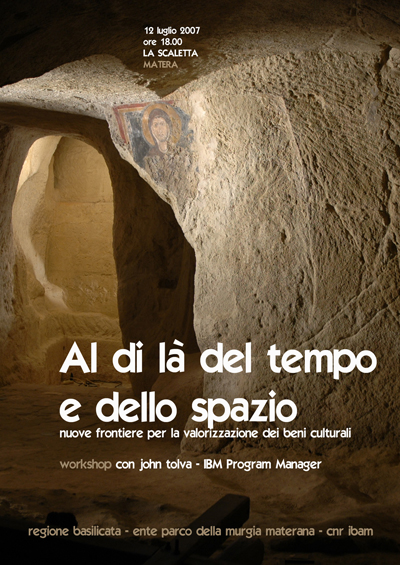
From the poster it looks like I will be lecturing inside of Yoda’s hut on Dagobah. In fact I’ll be speaking to university students and cultural heritage professionals on the topic of … um, “nuove frontiere per la valorizzazione dei beni culturali”. Duh. Have some work to do before Friday.
(Matera is an amazing city, by the way. Much more on it to come …)
Of orphans, the dead, and a house on a street that does not exist
Last weekend the boys and I set off on the last major pre-Italy fact-gathering adventure. Actually it was kinda morbid or, at least, odd for a five- and three-year-old. The goal was to visit my great-grandparents’ residence in Little Italy, the cemetery where they are buried, and the orphanage where my grandfather grew up. Why? Not entirely sure. Not a lot of facts to be gathered at these places frankly. I guess I just had to see.
We started in the massive, mostly-Italian cemetery of Our Lady of Mount Carmel. It is a Roman phonebook written in weathered stone.
We hunted around the graves with a crappy map. It was sweltering. And we were being pummeled by sex-crazed cicadas. But the boys were troopers. Nathan said “So, Dad. Everybody’s dead here?”
“Yes, all dead.”
“Why are they in the ground?”
Didn’t have a great answer for that one.
We got the map in the sprawling mausoleum which really freaked out the boys. Except occasionally for soft strains of angelic choirs coming from somewhere it was supernaturally quite — a situation my children have never experienced. Also the smell. Not quite rancid, but certainly not right. We got outta there quickly.
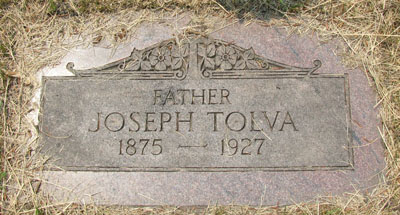
Back to the grave hunt. Basically Giuseppe Tolva doesn’t have a very elaborate grave, which is why it took us forever to find it. Most graves have upright markers and are visible from the cemetery roads, but his is flat with the ground all the way in the back of the vertical tombstones. I’d love to know who paid to inter him here and even more to know who put the artificial flower on the headstone. Interestingly there is no marker for his mistress nearby as we were led to believe. Just a joint grave for his two daughters.
The heat and bug assault was too much so we had to cut our hunt short for Grace, his wife. We decamped for Maryville Academy, the orphanage my grandfather grew up in when Grace died in childbirth with his brother. Frankly it was more depressing than the graveyard and even harder to grasp for my kids than the corpses in the ground.
“You mean the kids here have no parents? Why not?”
“Well some of them are dead and in the ground.”
The boys’ eyes enlarge to the size of silver dollars.
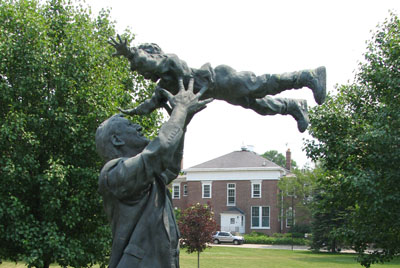
Actually Maryville isn’t an orphanage anymore. It serves physically, sexually and emotionally abused and neglected children. The old building, the beloved home of my grandfather (he maintained a relationship with the staff there all his life), is in sorry shape. It looks a bit like a dilapidated southern plantation house. The heat and cicadas made it feel all the more so. But still it felt like it could have been a good place for my grandfather. You’d not have been surprised to turn a corner and see this Maryville scene on a park bench. (Photo of my great-grandfather, great-uncle, and great-aunt circa 1920.)
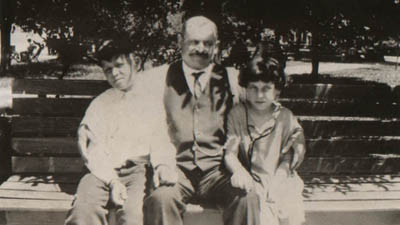
Back into the city with two very tired boys. The heat-spawned rain was starting to fall as we headed into Little Italy. I had recently found Giuseppe’s World War I draft registration card which contained an important (and unknown) reference to his residence at the time: 908 Sholto. It was in his own scrawl so I figured I was reading it wrong. Never heard of such a street in Chicago. So I found a list of all the streets. Nope, no Sholto. Great, doesn’t exist. Or maybe the UIC construction in the 1960’s destroyed it? Turns out, the street had only been renamed. 908 Sholto is actually 908 S. Carpenter.
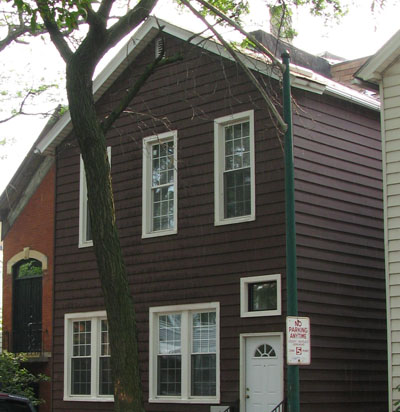
The kids had fallen asleep in the car by this point. It was pouring rain and I was prowling around the east edge of Little Italy looking a little suspicious. I’m pretty sure the home at 908 S. Carpenter is not the same one Giuseppe and Grazia lived in, but you never know. There are plenty of buildings that have stood that long. I have to believe they were crammed in there with other immigrants.
Yep, I guess I just had to see.
From Movable Type to movable type
On the flight to St. Petersburg I listened to the podcast of a session I missed at SXSW called From Blog to Book (audio). It was, duh, about turning one’s blog into a book. Now, don’t panic, I’m not naïve enough to assume that the content of this blog is worthy of bookdom. Seriously, I know. Nor do I assume that the number of readers of this blog constitutes enough of a market to make a print-run viable. But still. One can dream.
The upcoming trip to Barile just seems to me so apt for linear exposition, either as a series of articles or as a book. Why would it make a good story, you ask? Well, consider that I am hauling myself and my not-so-worldly parents across the ocean to a remote corner of Italy merely on the invitation of a municipal council whose only e-mail to me reads:
Dear Sir John Tolve, we’re the “Pro-Loco” of Barile in the province Potenza, Italy. We wold like to invite you to a conference and we want establish it (date) with your business. This event will be held next summer and we wish to award you for your activities developed in USA. As we are very prond of your “Barilese” origins and we would like to spend a celebration day with you. We are looking forevard to receive your news
My reply and subsequent re-replies have all bounced back because of a too-full mailbox in Barile.
Now, of course I’ve been in contact with others — a representative of the regional government, a family friend who is a travel agent in the area, a work colleague outside of Naples, and an Italian cousin whose coming in from Holland — but none of them really know what’s going on or what’s going to happen in Barile. This in itself I find interesting. As in, what the hell am I doing leaving my wife and children in Chicago to go to Italy for “a celebration day”? Might make a good start to a book, no? A mystery-travelogue of sorts.
So back to the podcast From Blog to Book. My expectations were fairly low since, let’s face it, not that many great bloggers have become great print writers. What esteemed example do they have on the panel? That’d be Tucker Max, author of tuckermax.com, one of the most offensively, hilariously puerile sites on the ‘tubes. Basically Tucker is a decent writer with an insatiable libido, a love of reckless inebriation, and zero moral qualms. As you might imagine, the session wasn’t exactly loaded with tips for aspiring writers because, well, humanity being what it is, anyone who can write well about drunken sex is bound to do pretty well for himself. As I do not plan on drunken sex in Italy (“day of celebration”, eh?) I am lacking a critical component of this sure-fire formula for success.
But I’d still like to try. Not sure where to begin (other than this blog, of course). Suggestions welcome. I know some of you out there have been published!
Of course, we’ll have to see what happens in Italy. My money is on the unexpected.
T-minus 3 weeks, 1 day.
Arbëreshë
A leading freedom fight dies in a war between faiths, west and east. Thousands of refugees flee to a neighboring country. Sound familiar?
This is Albania, 15th century. The Ottoman empire has amassed the largest army the world has known and is inching westward into Europe. The town of Krujë is under siege and has repelled two assaults under the command of George Kastrioti, known as Skanderbeg. During a third siege Skanderbeg succumbs to malaria. Krujë falls shortly thereafter and the Ottoman empire expands. Albania’s long resistance has given Vienna time to prepare, but the Turks are on the march.
In the next century nearly 300,000 Albanians fled their homeland, most to southern Italy. Modern Italy retains a link to Albania through the descendants of these refugees who established villages throughout the south. Barile, the birthplace of my great-grandparents, is one of these villages.
These Italians of Albanian descent are known as the Arbëreshë. They speak a language that’s basically unintelligible to modern Albanians (and of course Italians). It is the language of pre-Ottoman Albania, roughly equivalent to someone today speaking 15th century English in conversation. Despite not officially being classified as a protected ethnic minority in Italy, the Arbëreshë have retained customs and rites through to today, including a very peculiar singing style.
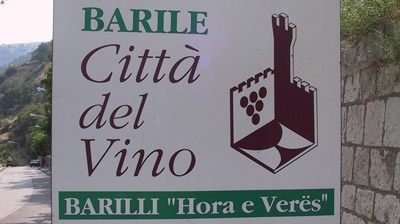
When I visited Barile in 1993 all the town signage was in Italian exclusively. In 2003 it was bilingual with Arbërisht underneath. I take this more as a tourist play than any kind of ethnic resurgence. Still, a good thing. As I’ve said before, the diversity of the south of Italy can be quite surprising, permitting glimpses into non-Roman cultures that you don’t find in the hills of Tuscany and alleys of Rome.
Of course, the struggles in Albania and the former Yugoslavia continue today. As does the exodus of refugees to Italy, particularly after the fall of communism. The most recent flight is excellently portrayed in the film Lamerica.
The ultimate social network
It is said that researching family history is second only to scouring the web for porn in popularity. I’m not sure if that’s true, but I can see how it might be so. If ever there was a medium perfectly suited to establishing lineage and contact with unknown family it is the Internet.
I’ve always had a simmering interest in genealogy, but the sorry state of family tree applications never got me very excited. These were almost always legacy beasts that could import the archaic GEDCOM standard file format and do little more. Where these apps really failed was in areas of collaboration and visualization. What good is a family tree if you are the only person who can work on it? And, much thornier, how do you slice and dice such a fractal dataset so that it is actually useful?
In recent years Ancestry.com has stepped in and taken care of much of the problem. Ancestry is run by the Church of Latter Day Saints (the Mormons) as a commercial offshoot of their ginormous genealogical holdings. The site is strictly secular though and offers an amazing array of backend research services that turns one’s offline family tree into a portal to dozens of historical record repositories. Just upload (or enter) what you know and the site begins searching census records, immigration manifests, military archives — and the best of all, other people’s trees that link up with yours back in the mists of time. Depending on where you’re from you can flesh out your family rather easily. Just a few nights ago I actually got bored after taking my mom’s mom’s line back so far through the UK that my line proceeded through a reverse Norman invasion back to France in the 11th century. Goodness knows how far back the recorded lineage goes.
Perhaps the most entertaining feature of Ancestry.com is the “Find Famous Relatives” function, six-degrees of separation on steroids. Basically if you have a pretty fleshed-out tree (and especially if any branches of it stretch back through the UK), Ancestry returns a bewildering collection of well-known relatives. For instance, I am the seventh cousin twice removed from William Faulker. This means ol’ Will and I share the same great-great-great-great-great-great-grandparent, though this person is two generations off from me. (Twice removed is what you are to the first cousins of your grandparents.) Not exactly thrilling. Ah, but there is thrill. I am the twelfth direct cousin of Werner Von Braun. This means we share the same great-grandmother12. Let’s set aside that Herr Von Braun developed the V2 rocket for the Nazis and instead focus on his role as the father of the American space program, OK?
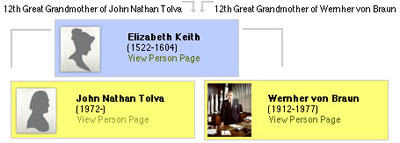
Even before I found Ancestry.com the web has been an inadvertent boon to family-finding. All you really have to do is get your name indexed by Google and it is off to the races. In the last six years I’ve been contacted by dozens of people with similar surnames or lineages who think they might be family. There’s Roberto di Tolve, a citizen and resident of Holland who was born in Barile, Italy and who is now a close family friend. Roberto travelled to Barile with my family and I in 2003. He’ll be back with us this July. There’s Stephanie Saville of the Paternoster line who traces her line to the famous winemakers of Barile. Most recently there’s Mike Botte who lives in NY and who grew up in Barile. (My great-grandmother is a Botte.) This may be the closest to true relation that’s been established simply from an e-mail. Mike’s cousin is the current mayor of Barile, who I will meet in July; so we’ll know soon. Much more on Mike and his extraordinary brother John in a future post.
So, ok, you get it. Online genealogy can be fun. But I am already seeing the underside of it. For one, it really does make you think hard about what family is. Genealogy is really about bloodlines, not family in the broader sense which includes step-relatives, foster parents, and illegitimacy. It charts gene propagation not family structure. In this way it is conceptually similar to The Genographic Project.
Also, you do come across people who treat genealogy with the same trainspotting zeal as online discographers. For example, finding a limited pressing of a Rolling Stones LP with a typo in the liner notes makes it more valuable; finding a misspelling on an emigration document might be a useful clue — but it might also be (and usually is) merely a massive pain in the ass. There’s a kind of genealogy buff I’ve come across that doesn’t really get this distinction.
Day of the Lucani
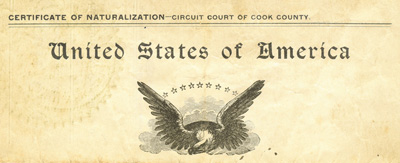
Sunday May 20 was The Day of the Lucani when Italy celebrates all those of Basilicatan descent wherever they may live. Now, references to this “holiday” are mighty scarce and not altogether consistent, but the Internet says it exists. And I believe everything the Internet tells me.
In a stunning coincidence the day truly was of the Lucani for my parents and I. We set about a trek around the Chicago area to talk to older relatives on the Tolva side and to pilfer through their photos and documents. It was depressing in a way, because talking to these few living family members reminded us that we’d already lost the majority of the family history. There’s no one on that side alive from my grandparents’ generation. Why do you only become interested in genealogy once your primary sources are gone?
But memories remain and what we found is that sometimes those memories aren’t rosy. There’s a tendency — OK, I have a tendency — to romanticize the past and ancestors. Giuseppe Tolve, my great-grandpa and the man who came to America from Italy with his wife Grazia, has reached almost heroic status in my mind, for instance. But it turns out he was not what you’d call a great husband.
We’d long known that Grace died in childbirth with my great-uncle Paulie in 1920. However, the story of her burial were made clear to us this last weekend. The Botte family would not bury Grace in the plots owned by Giuseppe because of how he treated her during her life (details are sketchy, but the word “conniver” was tossed about — most think he was a philandering drunk). They buried her under her maiden name in the Botte plot. Ouch.
Decades later when my great-uncle Bill was near death he asked Paulie to donate his body to science. Paulie made some inquiries and was told that he would need to make backup arrangements in case science did not want Bill’s body. So, he thought, we can just use the empty plot next to Giuseppe, since Grace was never buried there. When Paulie contacted the cemetary he was told that this was not possible since “Mrs. Tolva” was buried right next to Giuseppe. But Paulie knew for a fact that Grace Botte was not buried with him. It turns out that one of Giuseppe’s girlfriends (perhaps a barmaid, perhaps someone he legally married) indeed occupied the original plot for Grace. Double ouch!
Also, we learned that the four (of seven) children young enough to be placed in an orphanage earned the nickname there “Boozy Tolvas” because whenever Giuseppe came to visit he was drunk.
Ah, family history. I suppose if you dig you have to be prepared for dirt.
But there were also gems. Such as locating the original naturalization document for Giuseppe from 1904. This is step one in determining our eligibility for dual citizenship with Italy. What we need to determine is if the line “renouncing and abjuring all foreign allegiance …” is the same as officially renouncing one’s citizenship. If so, we’re hosed. If not, I may be on my way to EU citizenship. Any lawyers out there deal with this sort of thing?

A different kind of Basilicatan homecoming
So what’s the relationship like between the north and the south in Italy? In many ways it is similar to 19th century America where an industrialized, urbane north interacts with a rural, agrarian south. Yet, as in the American case, that’s a gross simplification. Being independent states and kingdoms for most of their history, the individual regions of Italy have a much more complex relationship to one another than American states have ever had.
We need look only to current events for an example. Basilicata was recently in the news regarding the bizarre tale of a would-be assassin and the lingering effects of regional tension.
Giovanni Passannante, a native of Salvia, Basilicata, tried to kill King Umberto I of Italy 120 years ago. He failed, was jailed, and went insane. As further punishment, the kingdom of Italy forced his hometown to rename itself. You will find Salvia listed on maps today as Savoia di Lucania (Umberto was of the house of Savoy). But it didn’t end there. Passannante’s skull and brain were removed and preserved in formaldehyde for study by criminologists. They’ve been on display in a museum in Rome for the last 70 years.
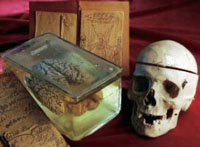
That is, until last week when the remains were to be publicly removed and interred with the rest of the body in a full ceremony in Basilicata. But that’s not what happened. A day earlier than planned officials squirreled the remains away secretly to bury them with no fanfare. Certain activists, especially in the south, are upset.
“No one wanted to deal with this case,” said Vito De Filippo, president of the Basilicata region. “No one had it in mind to confront this problem.”
Others see nefarious forces at work. Pesce lays the blame directly at the feet of the current mayor of Lucania, Rosina Ricciardi, who he claims was under pressure from traditionalists in the region to delay the burial and who he says had hoped to put Passannante’s remains once again on display, but this time in Lucania.
“In Italy there is a strong monarchical movement that should not be underestimated even though it seems ridiculous,” Pesce said. Repeated calls to Ricciardi’s office seeking comment were not returned.
De Filippo sees a parable in what could be the end of this long tale. “Passannante is a symbol of the south, and while everything is not resolved and the south still has many problems, we have the civility to close this story, by bringing him home.”
Full story: Dead anarchist becomes cause célèbre in Italy. Ironically, friends in Italy tell me that this story is not receiving nearly the coverage at home as it is in US press.
Of course, America has its own conspiracy theory regarding a southern assassin and his remains.
Of wine and caves
“There’s only one thing for certain. I will be back to Barile.”
I wrote that on a private family blog in 2003 at the end of a visit to Barile. I had no idea I’d be returning so soon. Over the coming weeks I’ll get into more about exactly why I’m headed back, but for now let’s look at what an interesting place this small hamlet is.
Barile, Italy is in Basilicata, one of the twenty regions of Italy. It is the instep of the boot, not the toe (that’s Calabria) and not the heel (that’s Puglia, which the NY Times loves). Basilicata is also known by its ancient name, Lucania; people from Basilicata are referred to as Lucani. The region is still one of the poorest in Italy, though it has made much progress since the 1950’s.
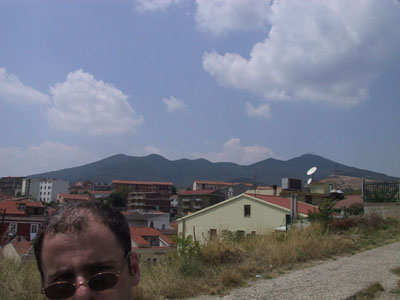
The town is situated on the slope of a gigantic, seven-peaked extinct volcano called Vulture. This geological phenom is the reason that the best wine in the region (really the best wine south of Rome) is made here. The volcanic soil and high elevation makes is the perfect environment for the late-blooming Aglianico grape. The particular local varietal, not surprisingly, is called Aglianco del Vulture and is sumptuous, a meal unto itself. Think of a Cabernet, then make it heavier and more tannic and you have Aglianico. It is not a light summer wine. In fact, it goes best if you can slay a wild boar with your bare hands and flame-roast it drenched in olive oil over a spit. When we did genealogical research in Barile in 2003 we learned that my great-great-great grandmother Carmela Paternoster, is an ancestor of Vito Paternoster, present-day owner of the Azienda Vinicola Paternoster, the premiere winery in Basilicata for the production of the Aglianico. Nice pedigree, eh?
Still, the town is rustic. I’ve been twice and never seen anyone under 30 who was not a child. Maybe this is changing as the region becomes more appealing to tourists and industry. It will be interesting to see in July. The town is known for the caves, called sassi, which line the ridge of soft rock underneath the town. Up until the 1950’s this is where most townsfolk lived. In fact, many families are still in possession of the caves, such as my “cousin” (relationship unknown) Anita Di Tolve, who like most have converted it into a wine cellar/self-storage unit.
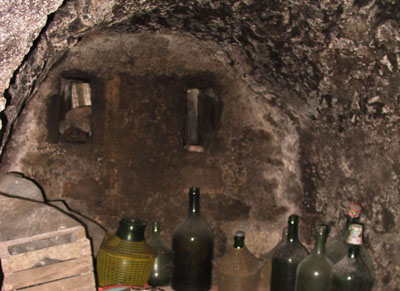
In 1993 when I was studying in Rome a buddy and I made a first trek to Barile. We were completely out of our element, barely speaking Roman Italian and arriving in the middle of siesta, but we did happen upon a man who understood us well enough to be intrigued that we were there in the first place. I can’t recall his name, but I do remember that he took us straight to his family cave. In retrospect it was probably a foolish thing to do. Two American idiots following a man they could barely understand into a dank cave to drink his homemade hooch. But we did it, the wine did not kill us, and we emerged unscathed and frankly quite pleased with ourselves. More on this first trip to Barile later.
Vulture was also the stomping ground of the young Roman poet Horace. It is a bit of a claim to fame for the area. Up near the caldera of the volcano which is now a gorgeous lake is a plaque embedded in the terrain with a stanza from his Orations where he describes lounging on the slope of the mountain.
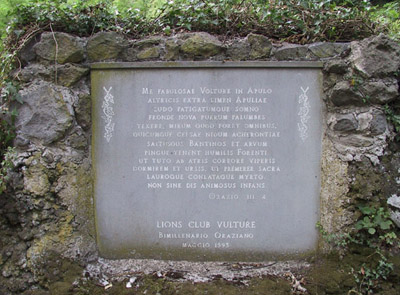
Hi, I’m John Tolva!
Mission Elapsed Time: 20:00:21:06:42:40
Recently this blog (and my Flickr account) turned 20 years old, forever in Internet years. I went back through it all, retracing digital footprints made on what feels like a different planet. Here are some highlights.
The Terror Tourist
A roughly monthly exploration of places in horror fiction — real or imagined, geographical or psychological — culled from The Heavy Leather Horror Show.
Subscribe to the podcast or the email newsletter or just read through the archives posted here.
The Ampcamper
How I hauled myself, two teens, an 80 lb dog, and a whole load of crap 4000+ miles across six states in twenty days using an electric vehicle. And survived to tell the tale.
Latest Photos
Marginalia
Stuff I’ve found interesting from around the web lately.


